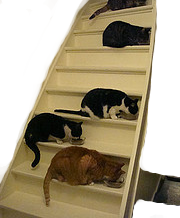Static electricity
Static electricity is a type of magic. It has had many uses throughout history, however recent concerns about its safety have led to a decline in its popularity.
History[edit | edit source]
Discovery[edit | edit source]
In 600 BC, electricians discovered that rubbing a piece of amber on a cat's fur would cause it to attract small pieces of polystyrene. This discovery led to the invention of the first apparatus for the mass production of static electricity, in which a number of cats are attached to the rim of a rotating wheel, aligned such that their fur comes into contact with a specially shaped block of amber.
Maintenance of the device proved to be almost impossible as the cats were rarely docile. Adding catnip to the amber alleviated the problems somewhat, but made the electricity smell somewhat unpleasant.
It was soon discovered that static electricity had the amazing ability to make balloons stick to walls. This ensured its commercial success. Soon every tavern and ale-house in the country boasted its very own cat-powered balloon charging machine.
Many inventors filed patents claiming that it was possible for the motion of such a device to be powered by the cats themselves via a treadmill arrangement, thus creating limitless static electricity seemingly out of nowhere. On closer investigation, however, almost all of these devices turned out to be frauds.
Formative years[edit | edit source]
By the early 1700s, the uses for static electricity were growing in number and variety, and maintaining the supply of cats presented great problems. Methods of storing and transporting static electricity were clearly needed.
Early attempts to use cardboard boxes to store the electricity proved unreliable and dangerous, as the electricity would leak from the bottom of the box and cause contamination of the ground. This proved especially problematic for sheep farmers as the escaped electricity would cause the sheeps' wool to stand on end. Any slight breeze would pick up the sheep and carry them for miles, much like a dandelion seed. The static electricity would then accumulate in the atmosphere, causing lightning.
Dutch physicist Pieter van Musschenbroek hit upon the revolutionary idea of storing the electricity in a jar. This proved much more reliable because a simple lid could be used to prevent the electricity from spilling out. His invention was titled the Leyden jar because nobody could remember how to spell "van Musschenbroke".
Experiments were also carried out to test the widely held belief that static electricity could be transported from place to place by conducting it through metal cables. The main proponent of this idea was the French clergyman and physicist Jean-Antoine Nollet who performed a spectacular demonstration of the principle in the spring of 1746. Two hundred monks from the Grand Convent of the Carthusians were arranged into a line over a mile long. Between each pair of monks was a 25-foot iron wire. On discharging a Leyden jar through the monks, they were observed to jump, twitch and swear simultaneously, confirming that static electricity could be transferred through the wires over great distances and at high speed.
Understandably it proved difficult to ensure that the monks maintained a steady grasp on the wire. This greatly limited the usefulness of Nollet's invention for the bulk transport of large quantities of static electricity. However it was soon realised that the device presented a highly practical method of communicating over long distances, and later on the so-called "electric telegraph" would become an extremely common feature of everyday society.
Later in the 1700s Benjamin Franklin became interested in static electricity after one of his regular kite-flying sessions was interrupted by a thunderstorm. Franklin went on to harness the power of static electricity for numerous purposes, leading to the invention of the lightning rod, the glass harmonica, the Franklin stove, bifocal glasses, the urinary catheter and the US Constitution. Franklin also attempted to use static electricity as a method of execution; while he failed to scale up van Mushenbrok's invention to human electrocution size, variants of his ideas are still used today in Kentucky Fried Chicken franchises the world over.
At around this time, the Italian wasp-herder Luigi Galvani was experimenting with frogs' legs. He discovered that they could be made to twitch by applying a discharge of static electricity to them, and predicted that a generator of static electricity could be built using frogs instead of cats. The machine failed to work, leading to his ideas being widely denounced as fraudulent by the scientific community of the time.
Golden age[edit | edit source]
At this point, people hit upon the idea of using conveyor belts to transport van Musselbrake's jars of electricity from place to place. Suddenly, the generation of electricity could be centralised. An entire industry was born as the demand for highly trained feline engineers blossomed. Whole towns were born around the newly established catteries. Great wooden catwheels dominated the skylines of every town and city; rattling conveyor belts ran alongside every major road, watched over vigilantly by armies of Nollet's monks, twitching furiously with telegrams and messages of every form. At one point, over half of the adult population was employed in the industry of breeding cats and tying them to wheels. The steady increase in thunderstorms was dismissed by the public as a fair price to pay for progress.
However it was not until the invention of the van de Graaff generator that static electricity reached its zenith. This revolutionary device did away with the live cats completely, replacing them instead with a belt of catskin. This machine was more time-consuming to produce but proved to be far more reliable and cheaper to run as there was no longer a need to feed the cats.
Downfall[edit | edit source]
The National Union of Catworkers were the first to object to the new invention. A series of strikes resulted in often bloody conflicts between the catworkers and the police. The new machine threatened the livelihoods of many; whole communities were destroyed as mass closures of catteries threatened to bring about the death of an entire industry.
Later on, distemper flared among the hippies. The manufacture of catskin belts was seen as an unacceptable exploitation of animals. As the traditional method had been in use for many hundreds of years, it was thought to be clearly more humane. For many years it was common to see so-called "organic" electricity offered for sale, which was guaranteed to have been produced only using live cats.
The tension with the hippies entered the public eye dramatically in June of 1985 with the so-called "Battle of the Catfield". Many thousands of cats had been rescued by the hippies from certain death at the hands of the catskin manufacturers. They were cornered in a field by police and soundly tasered. The discharge of static electricity from the tasers caused many of the cats to become charged and float into the sky; the resulting thunderstorms were the worst in living memory, resulting two years later in a hurricane which even Michael Fish was unable to predict.
This was the real death knell for static electricity. Public concern rapidly mounted over the environmental consequences of its accumulation in the atmosphere. For hundreds of years, spilt static electricity had sent everyday animals floating into the sky, and the increasing lightning storms were leading many to fear that the world was on the brink of imminent environmental collapse. The tide of public opinion rapidly changed against static electricity and its popularity began to wane.
Modern usage[edit | edit source]

Static electricity is mainly used today for its ability to make people's hair stand on end. This is useful not only for fashion purposes and in barber shops, but also for the production of horror films and, surprisingly, the pasteurisation of milk.


